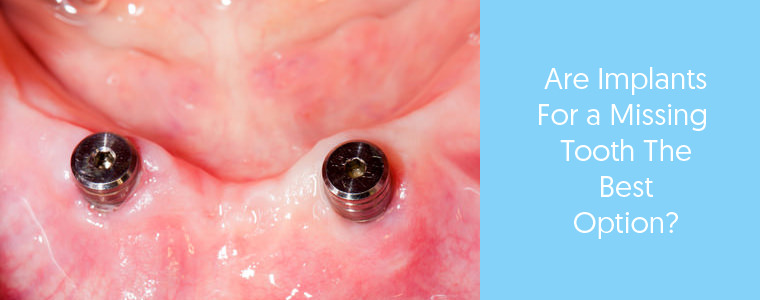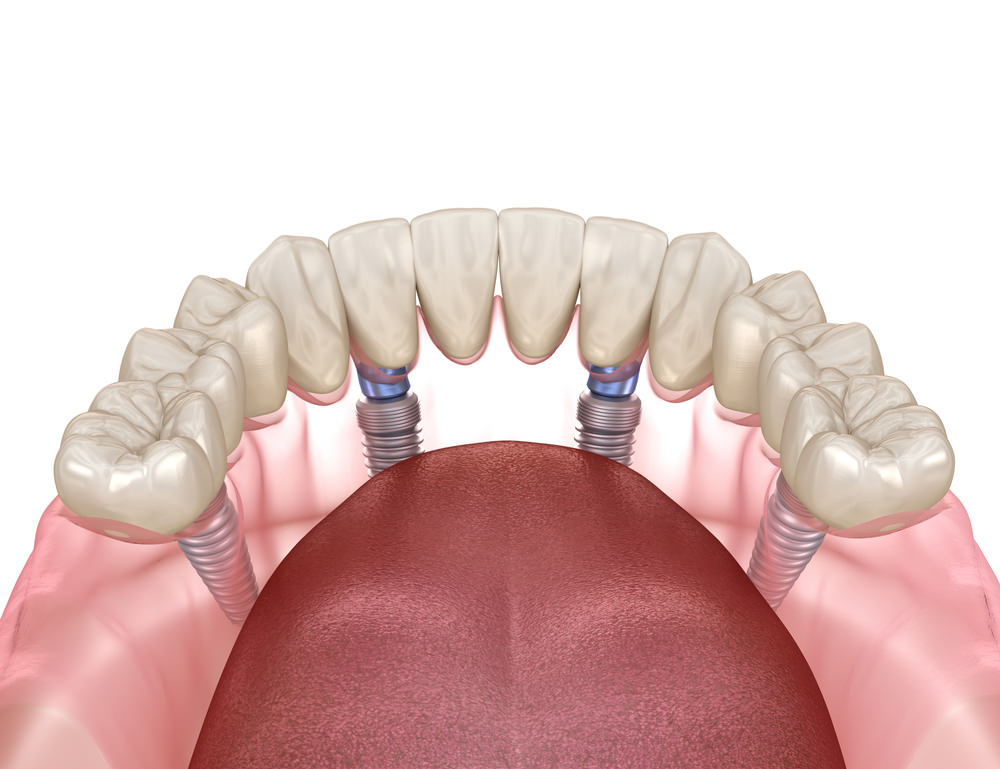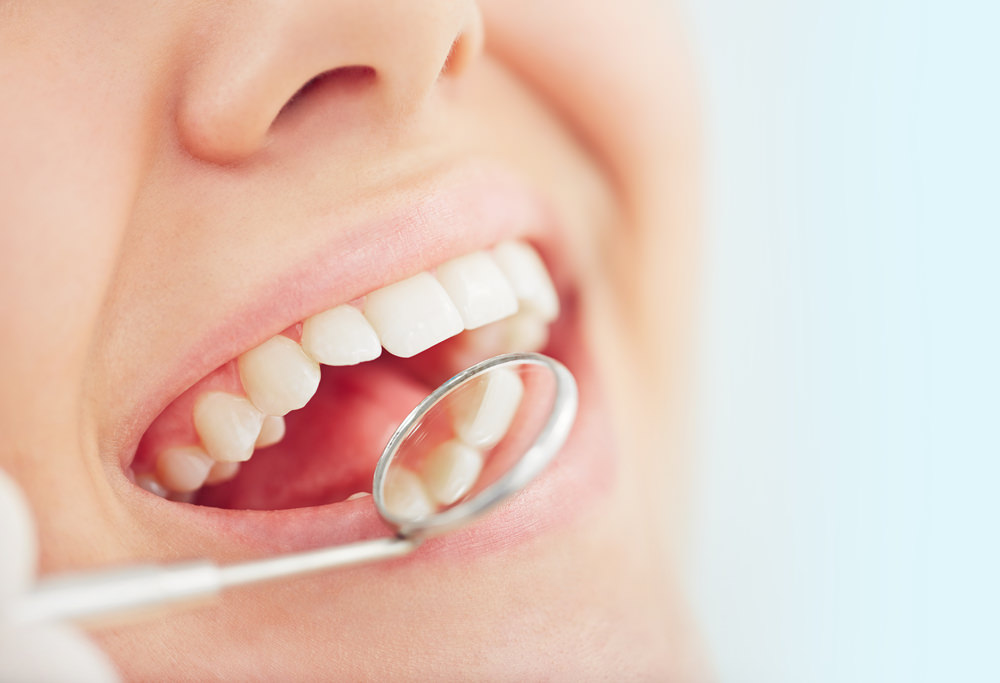Implants for a Missing Tooth
If you are struggling with the problem of missing teeth, there are many options for their replacement within the dental industry in this current day and age.
One of those such options is that the missing tooth can be replaced by an implant, which is then topped off with a crown.
This implant replaces not only the missing tooth but also its entire root structure – bone, ligaments, nerves and all.
However, implants are only one solution to replacing missing teeth, and although they have become more common in recent years, they are not necessarily always the wisest option.
Your Dentist may be able to provide you with alternatives such as bridges, which generally cost the same but last much longer, and there is far less chance that your body will end up rejecting.
Implants can’t be all bad though, you must be thinking, otherwise, they simply wouldn’t be an option. Well, you’d be right.
This post is all about implants and whether or not they are a wise option for you. It will help you to gain insight into some of the most important things to take into consideration. These include:
• Whether you are looking to replace one or more teeth
• The condition of your mouth and surrounding teeth
• Your age
This post is a little longer than normal, so see below a Table of Contents. This will help you skip straight through to any section you would prefer to read.
TABLE OF CONTENTS:
1. What are Implants?
2. When is it a good idea to get implants?
3. Is it ever a wise idea to have an implant for just one missing tooth?
4. What are the repercussions of getting implants?
5. Bridges vs. implants – what is the better option?
6. What are the benefits of implants?
7. How long should I expect my implants to last?
8. What is the process for receiving one implant?
9. How do I take care of my implant?
10. Will getting implants hurt?
11. Will my health insurance cover the cost of my implants?
Let’s get to thinking about what the wisest replacement for your missing teeth is – we want to help you create a brand, sparkling and gap-free new smile that you can enjoy with laughter, that will help to boost your self-confidence after you finish up at the dental office.
Ready? Okay, get set, and here we go…
#1 What are Implants?
Dental implants have been around for quite some time – invented in the 1950s, the research has continued and the studies have refined over the last 40 years, and an item has been presented that has made a significant advancement in the dental industry,
An implant is a piece of titanium (metal) that looks like a screw.
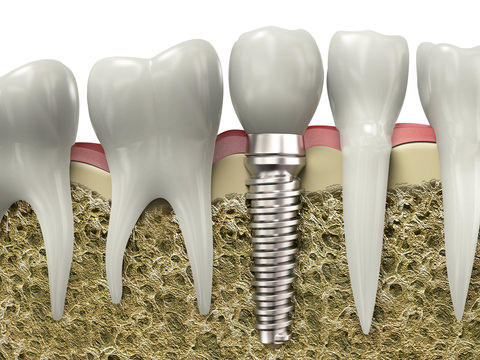
An illustration of what a dental implant looks like.
It is inserted directly into your jawbone, where your missing tooths roots (including bone, ligaments and nerves) once were.
After a few months, new bone will begin to grow around the implant, helping to hold it in its place.
A crown made in the laboratory from an impression of your mouth is screwed to the top of the implant to fill the gap of the missing tooth.
This means the implant now looks realistic in size, shape and colour – just like the rest of your teeth alongside it.
#2 When is it a Good Idea to get Implants?
If you are relatively young, and your other teeth are absolutely untouched, and all in a good and healthy condition, getting an implant is a good idea.
However, if your mouth is quite worn, and the other remaining teeth are very heavily restored, then not so much.
A better option is to put the crown on those very heavily restored teeth and then put false teeth in the middle.
A bridge is always the best, most secure option, as it helps to aid all of the other remaining teeth if you have a fully restored mouth.
#3 Is it Ever a Wise Idea to have an Implant for just One Missing Tooth?
Short answer, no. This is because an actual natural tooth has movement in it – the tooth being held into the body with a ligament.
An implant simply does not allow for this form of movement.
If the implant is placed in a position where it is hitting too high in a bite, there is no ligament there, and you will be getting too much pressure on the surrounding bone.
Over time this bone will end up giving way as your body sets up an inflammatory response around the bone, and as a result, you will end up losing the implant.
You will even begin to feel a pounding of the bone that is holding the implant in place.
This is because it has been placed in a position where a tooth once was, and that tooth had a ligament that had some form of give, or movement, to it, where the implant just has no give.
Stereotypically speaking, the only real applicable candidate for this type of procedure is a child who has a congenitally missing tooth – that is, they were not born with that tooth, so they never had that form of movement in that part of their mouth from the beginning.
However, you would not put an implant in them as a child, because their mouth will keep growing, and an implant will not.
Usually, the dentist will wait until a boy is older than 21, a girl is older than 18, so there is no longer a difference in the height of the gums.
#4 What are the Repercussions of Getting Implants?
Firstly, please note that a young person with missing teeth should never be touched – no restorations are to be performed on their teeth.
The only cosmetic procedures that may be performed on children are filling a gap because they have had a tooth knocked out. This is due to the fact that they are still growing – you would not put an implant in the child as their mouth keeps growing, and an implant does not.
Older people tend to get implants believing it is the wiser option, thinking there will be no consequences, but you need to remember that implants do come with their own set of problems.
General problems are the same as those with natural teeth – if you have lost a tooth, chances are, you will probably lose an implant.
If you have the type of bacteria in your mouth that actually eats the bone away, it is very likely that nothing has changed and you’re going to end up having the same problem with your implant.
This may be a result of your diet and lifestyle – cigarettes, a lack of nutrients, a very heavy bite, fractures and even bruxism (tooth grinding).
All you will be doing by getting implants is spending your money on something that may just go to waste.
A much wiser option is to get a bridge, which will also help support your surrounding teeth throughout the procedure.
#5 Bridges vs. Implants – What is the Better Option?
If you are in a position where you have lost a tooth, and the other teeth surrounding it are in bad condition, it does not seem wise to spend your money on an implant that may just end up going to waste.
If you have just one gap, and all your other teeth are badly decayed and heavily restored, fitting an implant simply does not make sense financially.
Instead, you could be putting your money towards saving the other teeth, prolonging their life, and at the same time replacing your lost tooth – all of this can be done by getting a bridge.
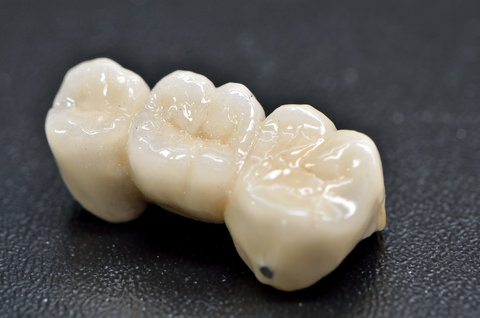
A 3 unit dental bridge for a missing tooth.
A bridge for one missing tooth and an implant for one missing tooth both generally cost the same, and generally speaking, the bridge will also last longer than the implant. Implants are known to last up to ten years, whereas bridges have a life expectancy of anywhere from ten to forty.
It is also not advisable to put an implant together with a natural tooth is because they have different compression strengths and different lateral strengths.
If you are fitting implants, the most advisable option is to join two to three implants together with a bridge. This will actually manage to hold off some of the forces as they are more balanced, once again helping to create something with a longer life expectancy.
- Implants look and feel just like your natural teeth – This helps boost your self-esteem and make you happier and more confident with your smile.
- Implants make it easier for you to both eat and speak than bridges – This is because they are secured to your jawbone, so there is less movement in the mouth.
- Implants are more comfortable and convenient – Because they are made to become part of you, this eliminates any of the discomforts that comes from a removable bridge.
- Implants generally tend to reduce any long-term risks posed to the jaw.
• How well you take care of your implants, including keeping up with your regular dental cleaning regime
• Your diet – you should avoid chewing on hard or chewy foods, or even chewing on hard things such as the end of pens, or opening things with your teeth
• How skilfully your dentist performed the procedure
• Uncontrolled diabetes
• A smoking habit
• Vulnerability to gum disease
• Infection around your implant area
• Tissue or nerve damage where you may notice pain, tingling or numbness in your chin, lips, gums or natural teeth
• Sinus problems
• Peri-implantitis, where the bone and gum around your implant becomes inflamed from unnecessary biting or a bacterial infection
You should visit your Dentist every six months for regular check-ups. This will help ensure that your implant stays in a healthy condition and does not need replacing.
#8 What is the Process for Receiving One Implant?
An implant procedure is a minor surgery to replace a missing tooth.
Unlike bridges, which can easily be removed, implants are placed into your jawbone in a series of appointments.
If there is what is known as an “edentulous space”, or a gap where your tooth has been taken out a long time ago, that has healed, and there are no problems in the area, your Dentist will simply put the implant in on the very first appointment.
Then, if they are intending to put a temporary crown in, they will leave the actual oral cavity and the implant, joining them together for the time being with a temporary tooth.
There is then a waiting period as it takes three months for the bone to heal around the implant.
At the second appointment, the temporary tooth is removed and replaced with a permanent tooth. An impression is taken and sent to the laboratory where it takes two weeks for them to make a crown.
This is fitted to your teeth, and all you have to do from here on forth is attend regular follow-up appointments – roughly two to three – where your Dentist will ensure the health of your teeth, your bite, and monitor the implant until you are comfortable and happy.
If the implant has been put in, you may end up requiring what is known as primary closure – this is when the gum must come together and heal over the implant so that it is not exposed to the oral cavity, perhaps a result of some form of complication or an issue that has arisen, ending in the gum needs to be closed over so the implant itself can heal.
It is not opened to the oral cavity because it could get bacteria in there, but instead, a graft is put around it, which makes extra bone around the implant to close it up.
Once closed, it is left alone for another three to four months, until you have a follow-up appointment where your gum is cut.
Then, another part on the oral cavity such as a healing cap or temporary crown gets screwed on to the implant.
In these cases, it is very important that the gum heals around the implant. Once the gum has healed around the implant whilst wearing the temporary crown, another appointment is attended where the impression gets taken and sent to the laboratory for them to make a crown.
Once again, you are monitored until your Dentist is happy with the health of your teeth, and your bite.
#9 How do I take Care of my Implant?
To ensure the longevity of an implant, it is crucial that you take proper care of it, keeping it clean and free of any bacteria and plaque that can lead to infection and cause the implant to fail.
This includes cleaning the implant in-between where the gum and the crown fit together.
To do so, it is important that you have the right equipment – special toothbrushes, Waterpik (a type of water flosser more effective for improving health around implants), anything that helps you get in and remove food debris that has gotten stuck in and around this area.
A good dental cleaning regime must be followed at all times. This includes;
• Brushing your teeth at least twice a day with a soft-bristle toothbrush
• Using the proper toothpaste (recommended by your Dentist)
• Brushing around and underneath the implant crown
• Flossing with Waterpik
• Rinsing
#10 Will Getting Implants Hurt?
Everyone wants to know… before, during, or afterwards – is the process of getting implants going to cause me any pain?
Each individual’s case is different, but the majority of the time, however, if the procedure is straightforward, the pain afterwards can simply be masked with Panadol until you have healed, so as you can imagine you will be feeling little to no discomfort.
In a more severe case, the extent of your pain will all depend on how far your Dentist actually has to reach into your mouth – if they actually have to raise a flap (cut your gum), or if the bone is being removed, or if grafting is performed.
It really is dependent on the amount of injury that is done to the mouth at the time and placement of the implant, as to exactly how much tenderness you will feel afterwards.
You may have some bruising, pain, and swelling of your gums and face, as well as some bleeding from your gums. You may also be given anaesthetic during the surgery, so that you do not feel any pain.
Keep in mind that if this is the case, you may not be able to drive for 24 hours afterwards and you may also feel mild pain afterwards.
#11 Will my Health Insurance Cover the Cost of my Implants?
Short answer – yes. Check out the Terms and Conditions of your Health Insurance Policy of course, but as long as you are covered for what is known as Major Dental, you have the correct level of cover and you will be covered for the cost, or at least a portion of the cost, of your implant/s.
It is important to note that many insurance companies see both implants and bridges as costly treatments, hence your need to ensure that you are covered for Major and not Minor Dental.
If you are contemplating treatment for a missing tooth, consider speaking with your insurance provider prior to deciding on your option – this may provide you with helpful information in deciding which procedure you wish to choose.
Conclusion
If you are missing teeth, one option that you may be contemplating to brighten that smile of yours is dental implants.
Implants have certainly been designed to boost your self-confidence – they look and feel like your very own teeth, are a relatively comfortable and convenient option, can be covered by health insurance, and they also improve your speech and make it easier for you to eat.
All sounds well, right?
Unfortunately, wrong. They do have their downfalls too.
Not designed for children, many older people get implants believing they are the wiser option, believing there will be no consequences, but unfortunately that just is not the case.
There is a high chance of failure if you get an implant and you have already lost a tooth in the past, damn that bacterial infection in your mouth.
Diet and lifestyle factors including a smoking habit, a lack of nutrients, a very heavy bite, fractures, tooth grinding, all that and more can also lead to the loss of an implant.
It is also very crucial that you take proper care of the implant, keeping it clean and free of any bacteria and plaque, or this too could lead to loss.
This includes cleaning the implant in-between where the gum and the crown fit together, and brushing, flossing and rinsing on a regular basis.
Happy to commit to a healthy diet and lifestyle and regular dental cleaning regime?
If you are in the right age range, depending on how many teeth you are looking to replace and the condition of your surrounding teeth, implants may be for you.
However, consult with your dentist as there is a high chance you may be recommended bridges instead – and there is nothing wrong with that, as bridges are designed to last just as long, if not longer, and there is far less chance of your body rejecting them, and they also generally cost the same as implants too.
Either way, there’s no reason once choosing the right option you should not leave that dental chair enjoying your brand new gap-free smile.
By Dr. V
Created at May 16, 2019, Updated at January 25, 2025


